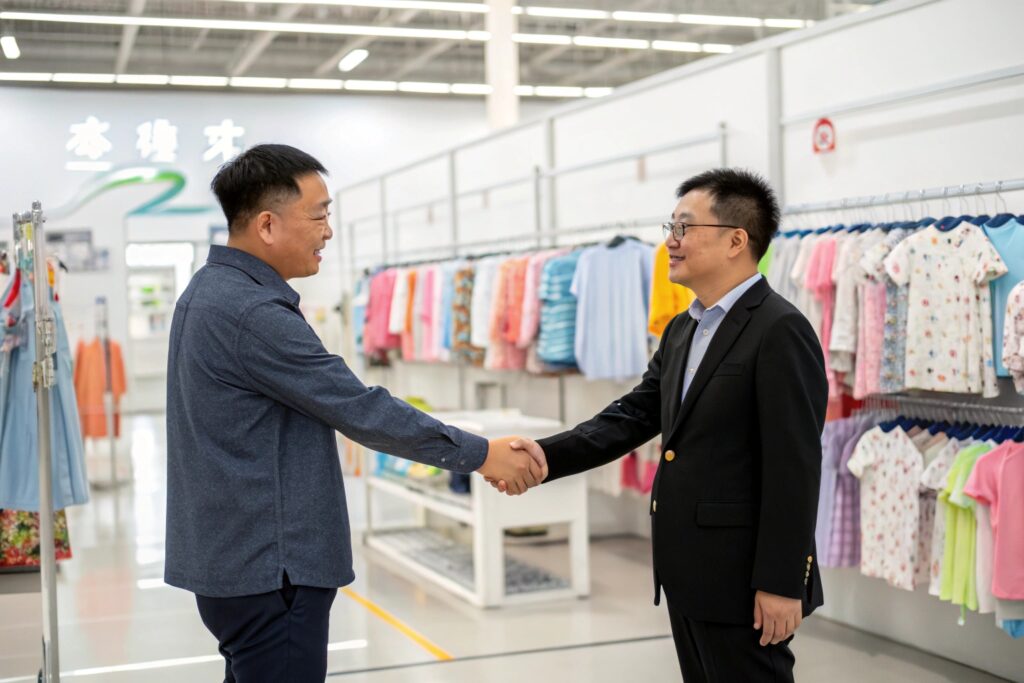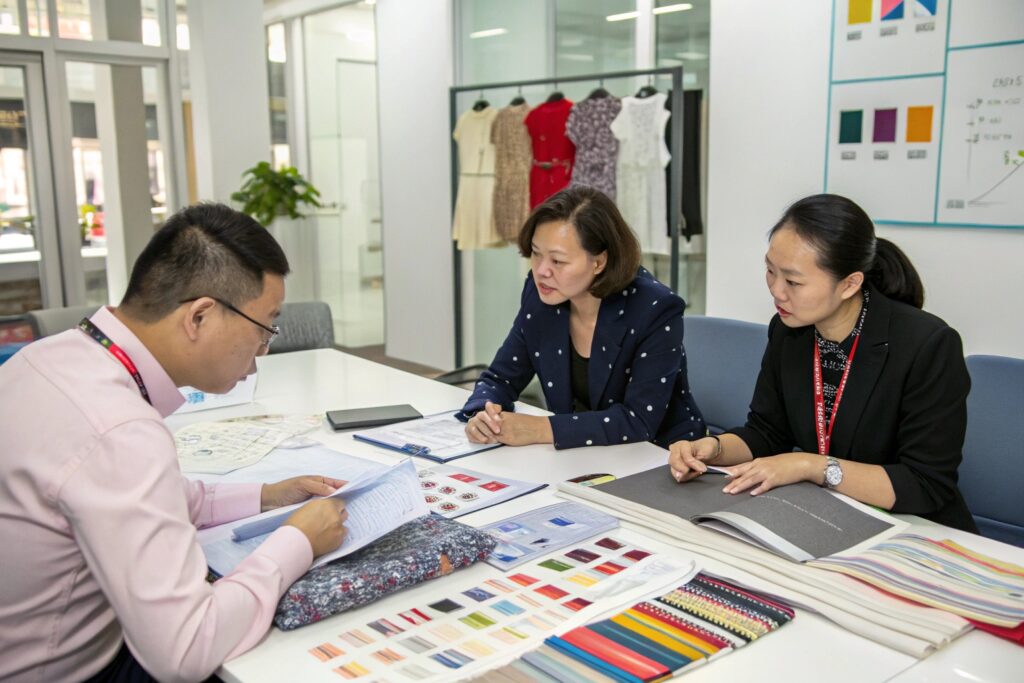If you're sourcing kidswear for your business, finding the best wholesale prices is not easy. High markups, hidden fees, and slow communication can stall your profits.
You can get children's wear wholesale prices by working directly with certified suppliers, especially in Asia, who offer factory rates, customization, and low MOQs through trusted platforms or sourcing channels.
There are thousands of sellers online. But not all of them are real manufacturers or offer good prices. If you want to keep your cost low and margins high, you need to know where to look and how to evaluate.
Which platforms offer low-cost kidswear in bulk?
The internet is flooded with vendors claiming to sell at wholesale. But only a few offer real bulk pricing with clear quality control. Many platforms act as middlemen, driving up your cost without adding value.
To get low-cost kidswear in bulk, use platforms like Alibaba, Faire, and FashionGo for verified suppliers, but direct sourcing through factory websites or trade shows often gives you better prices and custom options.

What platforms cater to verified factory suppliers rather than traders?
Many sourcing platforms mix real manufacturers with trading companies. This makes it hard to tell who you're dealing with. On Alibaba, check the “Manufacturer” tag, factory audit reports, and years of operation. Global Sources also has verified suppliers, often with stricter certification requirements. Faire and Tundra target Western wholesalers but have fewer Asian factories listed.
| Platform | Real Manufacturers | MOQs | Customization | Target Buyers |
|---|---|---|---|---|
| Alibaba | ✅ Yes | Flexible | ✅ Yes | Global |
| Faire | ❌ Mostly Traders | Higher | ❌ Limited | USA, EU Retailers |
| Global Sources | ✅ Yes | Medium | ✅ Yes | B2B Importers |
| FashionGo | ❌ Mostly Wholesalers | High | ❌ No | USA Domestic |
| Manufacturer Website | ✅ Direct | Very Low | ✅ Full | Global |
If you're serious about price control, going off-platform can be the smarter choice. For instance, my company Fumao Clothing offers direct factory pricing through our website without any middlemen markups.
What should I check before trusting a kidswear supplier on a platform?
Before committing to any supplier, always look at:
- Factory audit reports (BSCI, SEDEX)
- Product certifications (OEKO-TEX, CPSIA)
- MOQ policies
- Customization ability
- Shipping terms (e.g., DDP, EXW)
- Sample availability
Remember, just because they’re listed on a big platform doesn’t mean they’re real or experienced. Look for detailed company profiles, factory videos, and test orders.
Where to buy children’s clothing at factory rates?
If you're paying retail-style prices, you're already behind. Getting factory rates means bypassing brokers and working with the source. But factories don’t always advertise clearly.
You can buy children's clothing at factory rates by connecting directly with manufacturers like Fumao Clothing in China, who offer B2B pricing, low MOQs, and customization through their own website or trade shows.

What kind of factories offer real wholesale prices for kidswear?
Factories that specialize in OEM/ODM services are ideal. These companies allow you to:
- Customize designs
- Add private labels
- Negotiate bulk discounts
At Fumao Clothing, we run 5 production lines focused on kidswear, women’s wear, and men’s wear. Our bulk buyers, mostly from the US and Europe, rely on us for factory-direct pricing under DDP terms, which simplifies cost control.
You can also find factory-rate sellers in countries like Vietnam and India. But many lack English-language websites or fast response times. China still leads in factory accessibility.
| Country | Avg. Lead Time | Price Level | MOQ Flexibility | English Support |
|---|---|---|---|---|
| China | 15–30 days | Low | High | Excellent |
| Vietnam | 25–40 days | Moderate | Low | Moderate |
| India | 30–45 days | Moderate | Medium | Good |
What are the risks when sourcing directly from kidswear factories?
Going direct cuts cost, but also adds responsibility. You need to manage:
- Quality checks before shipment
- Clear communication on specs and timelines
- Contract terms to handle delays or defects
- Compliance documentation for customs
I’ve had buyers lose money because their supplier used fake certifications or delayed peak-season shipments. That’s why I recommend factories with in-house QC teams, like ours, to avoid these risks.
Are Asian suppliers best for wholesale kidswear?
Buyers often ask if Asia still holds the best deal for kidswear. With rising wages in China and trade shifts, it’s a valid concern. But low cost alone doesn’t mean best value.
Yes, Asian suppliers—especially in China, Vietnam, and Bangladesh—are still the best choice for wholesale kidswear due to cost efficiency, skilled labor, and flexible order structures.

How does China compare to other Asian countries for kidswear?
China remains the most reliable due to:
- Established supply chains
- Better factory compliance
- Efficient logistics
- Strong customization ability
Vietnam and Bangladesh offer lower labor costs but often require higher MOQs, longer lead times, and have weaker infrastructure.
| Feature | China | Vietnam | Bangladesh |
|---|---|---|---|
| MOQ Flexibility | ✅ High | ❌ Low | ❌ Low |
| Lead Times | ✅ Fast | ❌ Moderate | ❌ Long |
| Compliance Level | ✅ Strong | Moderate | Weak |
| Communication | ✅ Easy | Moderate | Hard |
Many of my clients started in Vietnam for the low prices, but returned to China due to delayed deliveries and lack of support for small batches.
What makes a good Asian supplier for wholesale children's wear?
The best Asian suppliers are those who:
- Provide DDP shipping options
- Share past work samples
- Offer in-house design support
- Handle multiple fabric types
- Speak fluent English or have professional sales reps
That’s exactly how we operate at Fumao Clothing. Our Western clients appreciate our quick replies, clear timelines, and scalable production—from 100pcs trial orders to 50,000pcs seasonal buys.
How to compare global kidswear price per unit?
Looking at total price isn’t enough. You need to break it down by unit and see what’s included. A cheap quote might lack labels, packing, or compliance.
To compare global kidswear unit prices, break down costs by fabric, labor, packaging, shipping, and customization. Always ask for DDP quotes with samples.

What cost elements affect per-unit pricing in kidswear?
Here's a simple breakdown of what affects per-piece price:
| Component | Description |
|---|---|
| Fabric Cost | Cotton, polyester, blends; price varies |
| Labor Cost | Cutting, sewing, finishing wages |
| Trim Cost | Zippers, buttons, labels, tags |
| Printing/Embroidery | Logo customization |
| Packaging | Polybags, hangtags, cartons |
| Shipping | Sea or air, DDP adds cost but reduces hassle |
| Compliance Docs | Testing reports, factory audits |
A $2 baby romper from one factory may seem cheaper than a $3.50 one. But if the $2 version lacks OEKO-TEX certification or proper packing, you may pay more later in customs or rework fees.
What tools or methods can help compare suppliers' prices fairly?
- Always request itemized quotations
- Ask for sample shipping options (FOB vs. DDP)
- Run trial orders of 100–300 units
- Evaluate cost-per-piece over full landed cost, not just factory price
You can create a simple Excel sheet to compare suppliers:
| Supplier Name | Unit Price | Includes Packaging | DDP? | Certifications | Lead Time |
|---|---|---|---|---|---|
| Factory A (China) | $3.20 | Yes | Yes | OEKO-TEX, BSCI | 20 days |
| Factory B (India) | $2.80 | No | No | None | 35 days |
| Factory C (Vietnam) | $3.00 | Yes | No | BSCI | 30 days |
The best supplier isn't always the cheapest. It's the one that saves you the most time and money across the full order cycle.
Conclusion
If you want competitive children's wear wholesale prices, work directly with trusted Asian factories, compare full landed costs, and prioritize quality alongside price.










